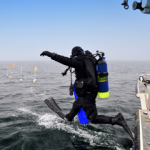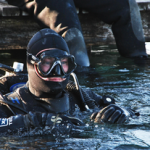
Are ankle weights necessary to avoid a feet first ascent in a drysuit?
In all my time diving in a drysuit, I have never had a feet first ascent. Plus I have never used drysuit ankle weights either. So let’s take a look at what can cause a drysuit feet first ascent and how to prevent it from happening. Plus whether or not it’s necessary to wear drysuit ankle weights too. Let’s take a look…
How to avoid a drysuit feet first ascent: How you avoid a drysuit feet first ascent is to not let your feet go above the horizontal. Also, consider drysuit ankle weights to help weigh your feet down. Others recommend to use your BCD for buoyancy instead of your drysuit. This way you have minimal air in your drysuit and reduces the risk of a feet first ascent.
The best way to do more diving is to book yourself on a scuba diving liveaboard. You can check the latest and best deals on liveaboards using the following window:
What is a drysuit feet first ascent?
A drysuit feet first ascent (or how some refer to it as a runaway ascent with floaty feet) is when you become inverted underwater with your feet pointing to the surface.
As you ascend in the invert position, the air in your drysuit expands and speeds up the ascent. On a normal upright ascent in a drysuit you use the dump valves to release the excess air like you would using a buoyancy control device.
But the reason why a feet first ascent becomes a massive problem is that it’s impossible to dump the air out of your drysuit in an inverted position. This is because the dump valves on a drysuit are usually on the shoulder and on the wrist cuff. The air in your drysuit migrates to the top most part, which in this case is to your feet.
A feet first ascent can quickly turn into a dangerous situation. This is because if you understand the physics of scuba diving, as you ascend from a dive, the air inside any cavity (for example your buoyancy control device) will expand. But in this case the cavity containing the air is your drysuit.
The more the air inside the drysuit expands, the faster the ascent becomes. You would continue to go faster and faster, as you ascend to the surface. This scenario would seriously risk you getting decompression sickness or the bends due to a fast-ascent.
What causes a drysuit feet first ascent?
The cause of a drysuit feet first ascent is often times when an inexperienced drysuit diver accidentally inverts. In an inverted position the air inside the drysuit rushes to your feet. This normally occurs when someone allows their feet to rise above the horizontal, which will begin the air migration to their feet.
If nothing is done at this stage, the air will continue to migrate to the feet and legs of the drysuit until you become completely inverted with your feet pointing up to the surface.
How to prevent and correct a feet first ascent in a drysuit
How you correct a feet first ascent is to act fast. You then need to curl up and bring your knees to your chest. The affect of curling up is that the air is forced out of your legs to around your torso.
You should then turn automatically, as the air is forced into the upper portions of your drysuit. If during the inversion you have begun to ascend, you will then be able to dump any excess air that has built-up from either of your dump valves.
To prevent a feet first ascent from happening in the first place, you should avoid your feet from rising above the horizontal. It’s too easy to find yourself pointing head down in a crevice or similar with your feet pointing towards the surface.
This is more likely to happen to divers who are using a drysuit for the first time or for the first few dives. However, you get to know or feel when the air begins to migrate. You can feel the drysuit around your feet expanding.
The trick to avoid the feet first ascent is to immediately drop your feet to below the horizontal. This is so that the air migrates back up to the upper sections of your drysuit.
The final tip regarding how to prevent a feet first ascent is to practice this in a pool environment where it’s safe to do so. Make sure there are others with you while you practice curling up and righting yourself from an inverted position.

Use your buoyancy control device for buoyancy instead of your drysuit
The other advice given and used by some scuba divers is to only add sufficient air into your drysuit to avoid drysuit squeeze. These divers would then revert to use their buoyancy control device for buoyancy.
However, I have always used my drysuit for buoyancy and I usually find that the amount of air needed to correct the drysuit squeeze is sufficient to create neutral buoyancy.
I prefer to use only one device for buoyancy, rather than tow devices. For me this is a safer option, as in a n emergency situation, your buddy will only have to dump air from your drysuit and won’t have to worry about any air in your BCD.
Correct weighting will help to prevent a speedy ascent to the surface feet first
As with any diving, you should make sure you are perfectly weighted on your dive. If you are you should find that you will never find yourself in the feet first ascent situation.
Are ankle weights necessary for drysuit diving?
Ankle weights are small weights that clip around the outside of your drysuit. These weights are in addition to your weight belt or integrated weighting.
In all the diving that I’ve dived in a drysuit, I never used ankle weights to weigh my feet down. I did buy a pair of ankle weights when I first started to use a drysuit, but I never found it necessary to put them on. This isn’t to say that they are not worth using, as many drysuit divers do wear ankle weights.
If you’re worried about a feet first ascent, I would recommend your focus on practising in a pool to avoid it happening. Plus focus on making sure you are weighted correctly. Also, and as already mentioned, for an added precaution use your BCD for buoyancy instead of your drysuit.
I hope you enjoyed this article about drysuit feet first ascent and ankle weights
I’d love to hear from you. Tell us about your adventures of diving and snorkelling. Please use the comments section below. Please also share your photos. Either from your underwater cameras or videos from your waterproof go-pro’s!
If this article hasn’t answered all of your questions. If you have more questions either about snorkelling or scuba diving (or specifically about drysuit feet first ascent and ankle weights), please comment below with your questions.
There will also be many more articles about scuba and scuba diving safety tips (and on snorkelling too) for you to read and learn about this fabulous sport.
Have fun and be safe!




